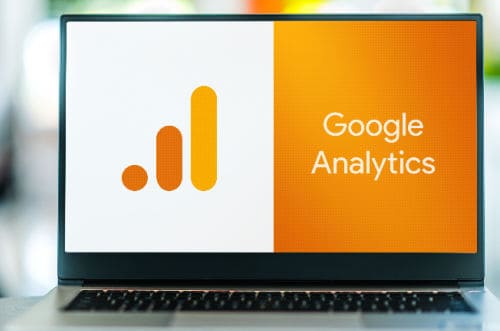If you currently use Google Analytics to track your website performance, you might have heard talk about the introduction of Google Analytics 4 (GA4) and the eventual termination of Universal Analytics. But what exactly does that mean for your business, and will you still be able to access the data you need to make informed marketing decisions? We’ve got the breakdown for you, as well as the next steps you need to take so you don’t lose access to critical information about your website.
Google Analytics 101
If you’re not currently using Google Analytics in your marketing strategy, you’re missing out big time. Both the old Universal Analytics and the new Google Analytics 4 track traffic on your website, such as how many people came to your website, where they came from, how long they were there for, and what pages they visited.
For marketers, that data is invaluable. It not only tells you how successful your website is at keeping people engaged, but it also tells a story about how effective your marketing campaigns are so that you can spend your marketing dollars more efficiently. Without this information to know whether your current marketing is working, you are pretty much making shots in the dark.
Why is Universal Analytics Going Away?
Simply put, Universal Analytics was built for a different time. A time when the majority of people surfed the ‘net on their desktops, and before there was a general wariness about third-party cookies. Now that Google has phased out cookies and pretty much everyone uses the web on their mobile devices, it is time for the analytic platform to change with the times.
How is GA4 Different Than Universal Analytics?
According to Google, GA4 is a better choice than Universal Analytics for both businesses and consumers. Since it’s focused on privacy and doesn’t store cookies, those visiting your website don’t have to worry about their personal data being compromised. It also offers a more seamless integration with Google’s other platforms so you can more easily optimize campaign performance.
The biggest difference in GA4 is the way it tracks and consumes data. Whereas Universal Analytics used “hits” to track when users went to a page or completed other actions on your website, GA4 uses events, where every interaction is captured as an event.
For marketers, GA4’s events-based data collection is a benefit for two key reasons:
- It allows for better conversion tracking. Since each interaction a person takes on your website can be now tracked as an event, it’s easier to map out your customers’ journeys and determine the conversion path for each channel.
- It will give you a better understanding of your typical customer life cycle. Event-based tracking, paired with GA4’s ability to track across platforms, captures the full experience of your customers so you can see how they interact with your business, from their first visit to your website to them becoming a loyal customer
When is Universal Analytics Going Away?
Universal Analytics will stop collecting new data on July 1, 2023. For six months after July 1, 2023, you will still be able to access UA data that was collected through June 30, 2023. However, on July 1, 2024, UA will no longer be available and all data that was stored on the platform will be inaccessible.
Unfortunately, none of the data from your UA account will be transferable to GA4. And any data available in GA4 will only go back to when your GA4 account was set up.
What Should You Do Now to Continue Collecting the Website Data You Need?
Step one – SET UP GA4 NOW! As we mentioned before, GA4 will only start collecting data after it has been configured, so the sooner you get it set up, the more data you’ll have down the line. In the meantime, keep Universal Analytics so you can keep collecting data through that platform as well.
Step two – Download your historical UA data. This is particularly important if you like to compare year-over-year data, as you will not have that information in GA4 for the first year. You will need to consider which reports mean the most to your company, such as monthly, yearly, etc., so that you can use the data in the future.
Step three – Run an audit of your UA customizations, including custom events, conversion tracking and custom segments, as these do not get transferred over automatically. You will need to add these customizations to your GA4 account after you have added the GA4 tracking code on your site.
Your audit will also be a good time to evaluate whether you are tracking events that are valuable to your business or not and make a new plan going forward.
TL;DR Takeaways
- Universal Analytics (UA) is going away and being replaced by Google Analytics 4 (GA4)
- Configure GA4 immediately to collect data alongside UA until UA is no longer available.
- Since data will not be transferred, make sure you collect the data you need from UA.
- July 1, 2023 – UA will no longer collect new data, historical data will still be accessible
- July 1, 2024 – UA no longer accessible and all website data will be accessible solely through GA4.
Need help making the switch to GA4? We can help! Our digital marketers will set up your GA4 account, download any historical UA data you need, and transfer your customizations, all for a one-time fee starting at $199. Contact us today at dawn@mwmsd.com!

